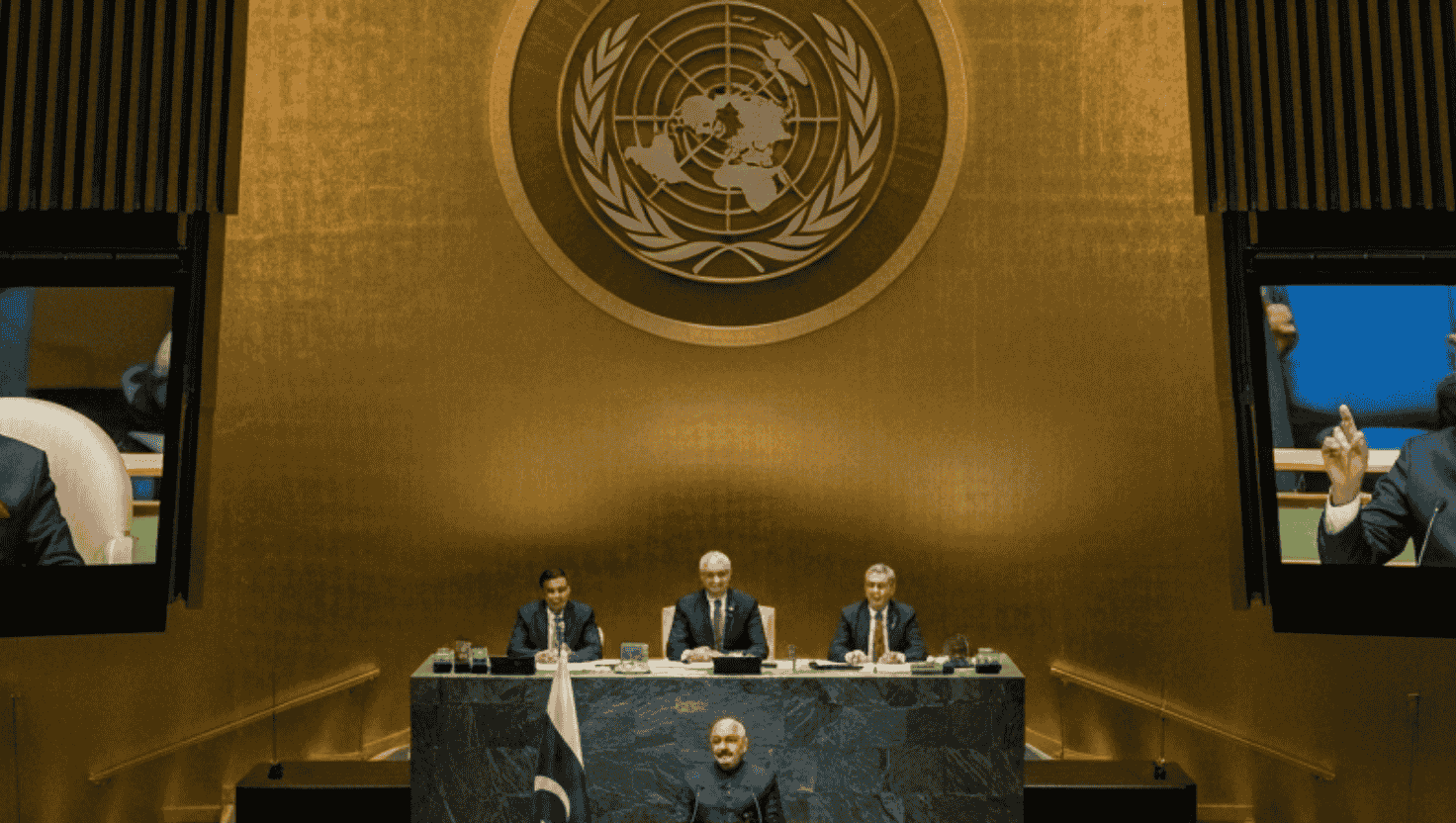Diplomacy has always been a game of words. It is a craft where sentences are bent, phrases polished, and truths carefully wrapped to suit national interests. In the world of global politics, words often cut deeper than swords. The international community witnessed this once again on the evening of September 26, 2025, in New York, during the 80th session of the United Nations General Assembly.
What unfolded between Prime Minister Shahbaz Sharif of Pakistan and India’s First Secretary Petal Gahlot was more than just an exchange of speeches—it was a duel of narratives, each side seeking to bend the story in its favor.
Prime Minister Shahbaz Sharif did not mince words. His address accused India of cross-border terrorism, water aggression, human rights violations in Kashmir, and, most notably, of suffering a clear defeat in the Indo-Pak conflict of May 2025. He reminded the assembly that Pakistan’s air force had brought down seven Indian fighter jets, turning them into what he described as “dust and scrap.”
To him, this was not just a military victory but also a statement of resilience—a reminder that Pakistan could defend its sovereignty when challenged.
When sarcasm turns into confession
India’s reply, delivered later that evening by Petal Gahlot, was swift and sharp. She dismissed Sharif’s words as “absurd” and ridiculed Pakistan’s claim of victory by saying: “If destroyed runways and burnt-out hangars look like victory, as the Prime Minister claimed, Pakistan is welcome to enjoy it.”
Within minutes, Indian media celebrated her remarks as a knockout punch. Headlines praised her “bold rebuttal” and “firm shutting down of Pakistan.” Television anchors spoke of how India had shown the world its strength through Gahlot’s words. But as the dust settled, a more careful reading revealed something different. Her statement, though delivered with confidence, raised more questions than answers.
Read More: Pakistan’s Role in Regional Narratives and Diplomacy
Diplomatic language is designed to conceal as much as it reveals. Gahlot’s remark about “burnt-out hangars” and “destroyed runways” was meant as sarcasm, but it also carried an unintended confession: these runways and hangars were indeed destroyed. The very act of referencing them acknowledged that Pakistan’s strikes had caused significant damage. These were not ordinary targets.
The attacks were aimed at high-security Indian airbases, many of which housed advanced defense systems and aircraft. Under such circumstances, no country could realistically evacuate all its equipment. Satellite imagery that surfaced in the days after the conflict confirmed this, showing visible destruction across several Indian installations. What Sharif described at the UN was not empty boasting—it was corroborated evidence.
Equally striking was what Gahlot chose not to mention. She skipped over the dogfight of May 10–11, when Pakistan’s air force claimed a decisive edge. This silence spoke louder than words. By ignoring the episode altogether, India left a gap in its narrative, a void that Pakistan was quick to fill with its own version of events.
The question, then, is whether India truly managed to “shun” Pakistan or whether it simply sought to manage the optics of an uncomfortable situation. For domestic audiences, Gahlot’s speech may have offered reassurance. It gave Indian citizens a sense that their representatives were standing tall at the UN. But diplomacy is not just about appeasing one’s own people.
On the world stage, credibility matters more than sound bites. Here lies the paradox: by leaning too heavily on rhetoric, India may have inadvertently underlined its own vulnerabilities. The international community is not easily swayed by clever phrases alone. With access to independent reporting and satellite imagery, global observers could see through the cracks.
They noticed the gap between India’s dismissive tone and the evidence of damage on the ground. In the effort to project strength, the statement came across instead as defensive.
What added another layer to the story was the contrasting coverage. Inside India, television channels and newspapers turned Gahlot into a national hero overnight. Clips of her speech went viral, accompanied by celebratory commentary. Yet outside India, the reaction was far more muted. Analysts and think tanks noted the absence of concrete counter-evidence in her reply.
Some even argued that her sarcasm only highlighted India’s difficulty in responding to Pakistan’s claims with hard facts. This difference in perception is crucial. While a country may succeed in shaping its internal narrative, the global stage operates differently. A clever one-liner may silence opposition momentarily, but unless backed by credibility, it risks being remembered as hollow.
Read More: Pakistan Slams India at UNSC for Sponsoring Cross-Border Terrorism
For Pakistan, Sharif’s speech achieved exactly what it was designed to do: put India on the defensive. By highlighting issues like Kashmir, water disputes, and the May conflict, he forced India to respond rather than dictate the agenda. In diplomacy, forcing the other side into a reactive position is itself a form of victory.
Sharif’s references to the May conflict also allowed Pakistan to project an image of resilience and military capability. Whether one accepts all of his claims or not, the fact remains that India’s rebuttal did not successfully dismantle them. Instead, by focusing on ridicule rather than facts, India left room for Pakistan’s narrative to linger in the minds of international observers.
The cost of rhetoric over credibility
The exchange at the UNGA offers some important lessons for Indian diplomacy. Mockery is no substitute for evidence. While sarcasm may please domestic audiences, it does little to persuade global ones. Omissions are noticed, and skipping over key events like the May dogfight weakens a country’s credibility.
Media euphoria is not global validation; celebrating a speech at home does not change how it is perceived abroad. For a country of India’s stature, credibility is a vital asset. If its representatives continue to rely on rhetorical flourishes instead of grounded facts, that credibility risks erosion. In an age where information is readily verifiable, diplomacy must align more closely with reality than ever before.
The late-night exchange of words at the UNGA on September 26, 2025, will be remembered as more than just another chapter in Indo-Pak rivalry. It showcased the power—and the limits—of diplomatic rhetoric. Pakistan’s Prime Minister Shahbaz Sharif used his speech to spotlight grievances and claim victory in the May conflict. India’s Petal Gahlot responded with sharp words and sarcasm, earning applause at home but leaving doubts abroad.
In the end, her words revealed as much as they concealed. By referencing destroyed airbases, she unintentionally acknowledged the damage Pakistan had inflicted. By avoiding mention of the dogfight, she left unanswered questions hanging in the air. And by relying on rhetoric over substance, she highlighted the fragility of India’s diplomatic strategy.
Diplomacy, after all, is not just about winning applause in the moment. It is about shaping long-term perception and credibility. On that evening in New York, India may have satisfied its domestic audience, but it struggled to convince the world. Words can be powerful tools, but when they are used to cover rather than confront reality, they risk exposing more than they hide.
*The views expressed in this article are the author’s own and do not necessarily reflect the editorial policy of TDI.

Maheen Riaz
Maheen Riaz is a visiting Lecturer at a public university in Karachi, where she enjoys engaging with students and sharing ideas through teaching. She is also pursuing a Masters in European Studies, a field that has greatly enriched her understanding of global and regional dynamics. Her research interests include diplomacy, foreign affairs, and international relations. She is passionate about connecting academic knowledge with real-world issues and contributing to discussions on global politics and diplomacy. She can be reached at mhnriaz.mhn5@gmail.com



